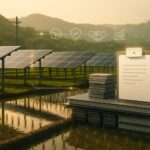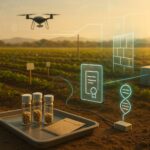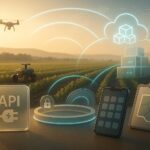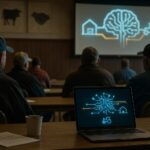In Locust Grove, Georgia, a 200,000-square-foot vertical farm packed with brand-new automation, lighting and climate systems is being sold off piece by piece. The former Bowery Farming site, once pitched as a showpiece of “farms of the future”, is now the subject of an industrial auction: more than $70 million of assets, including over $32 million in equipment that was installed, tested—and never used.
Forklifts and rigging crews will soon do the work that robots and conveyors were meant to do. Where software was supposed to orchestrate growth cycles by the millisecond, bidders now scroll through lot numbers on an auction platform.
At the same time, elsewhere in the controlled-environment agriculture (CEA) world, new money is quietly flowing again. A Canadian vertical farmer, GoodLeaf Farms, has just raised $52 million to expand its leafy-greens factories and build an R&D centre. A Florida developer, Harvest Singularity, is investing $66 million in a hydroponic greenhouse that promises three tonnes of salad a day. In Europe, SAIA Agrobotics has secured €10 million for an “inverted” greenhouse where plants ride conveyor belts to stationary robots, rather than the other way round.
The images sit uneasily side by side: a flagship American vertical farm being broken up for parts, while greenhouses and robotics platforms attract fresh capital. This is vertical farming’s split-screen moment—and it tells us a lot about how the business model is being rewritten.
Table of Contents
ToggleFrom unicorn to auction block
Bowery was supposed to be the proof that vertical farms could leave the experimental phase behind. Founded in 2015, the New York-based start-up raised more than $700 million from investors including GV (Google’s venture arm), Temasek and celebrity backers, and at its peak was valued at around $2.3 billion.
The company built a network of high-tech farms supplying leafy greens to major U.S. retailers and food-delivery services. It also took on debt to accelerate expansion, including a large facility in Locust Grove, Georgia, whose equipment is now up for liquidation.
By late 2024, the story had flipped. Bowery failed to secure a buyer or enough new capital, shut all of its farms, laid off staff and entered an assignment for the benefit of creditors. The Georgia facility never even reached full commercial production.
Bowery is not alone. AeroFarms, another early pioneer, filed for bankruptcy protection in 2023 before reorganising under new ownership. AppHarvest, a U.S. operator of high-tech greenhouses, also failed. Plenty Unlimited, which had raised nearly $1 billion from investors including Jeff Bezos and SoftBank, entered Chapter 11 in March 2025, closing its California leafy-greens farm and halting expansion at a Virginia site.
The wreckage is striking. But it does not mean the idea of farming indoors has been abandoned.
The bubble that burst
The bigger story is about capital.
In 2021, U.S. indoor farms attracted around $2.1 billion of venture capital across 76 deals, according to PitchBook data cited by the Wall Street Journal. By 2025, that figure had dropped to just $57 million spread over five deals.
Globally, analysts estimate that investors poured more than $6–8 billion into indoor and vertical farming between 2018 and 2022. The pitch was seductive: high-tech farms, close to cities, using 90% less water than traditional agriculture, free from pesticides and weather shocks.
But the underlying economics were always tight. Plant factories need expensive buildings, climate control, water treatment, LED lighting and automation. Electricity is the single biggest operating cost. Meanwhile, most vertical farms chose to grow commodity crops—lettuce and herbs—that compete directly with cheap field-grown produce.
A recent academic meta-analysis of indoor agriculture found that CEA accounts for less than 1% of U.S. food crops by volume, yet already consumes more energy than all open-field cultivation combined; in expansion scenarios, indoor systems could reach around 7% of national energy use. Fully enclosed plant factories, the category where vertical farms sit, are by far the most energy-intensive facility type.
As interest rates rose and investors lost patience with “growth at any cost”, the contradiction became hard to ignore: these were hardware-heavy infrastructure projects trying to run on software-style venture capital.
On paper, the market still looks like a growth story
Ironically, if you only looked at market reports, you might conclude that vertical farming has never been healthier.
One global forecast values the vertical farming market at $6.92 billion in 2024, projecting it to reach $8.52 billion in 2025 and $50.10 billion by 2032—a compound annual growth rate of almost 29%. Another sees the sector at $6.8 billion in 2024 and $36.8 billion by 2033.
Zoom out further and the controlled-environment agriculture market—covering greenhouses as well as vertical farms—is estimated at about $108 billion in 2025, rising to over $420 billion by 2035.
There are good reasons for this bullishness: climate change, water scarcity, pandemic-era supply shocks and urban growth are all pushing policymakers and retailers to look for more resilient ways to grow food. Technology costs, especially LEDs and sensors, have also fallen sharply over the past decade.
But the Bowery auction is a reminder that aggregate market forecasts can mask big differences in who is actually capturing that growth—and at what cost.

A rebound, but only in certain corners
Data from the 2025 iGrow Intelligence Dashboard suggests that an “indoor farming rebound” is underway, but it is narrow. Funding momentum is returning mainly in greenhouse infrastructure and enabling technologies—automation, robotics, AI-driven crop optimisation, substrates and advanced lighting—rather than in headline-grabbing megafarms.
Recent deals illustrate the pattern:
- GoodLeaf Farms, a Canadian vertical-farm operator, raised $52 million in equity to double capacity at its Alberta and Quebec sites—each around 100,000 square feet—and fund a new R&D centre in Ontario. Investors include Farm Credit Canada, Power Sustainable Lios and McCain Foods.
- Harvest Singularity is investing $66 million in a 325,000-square-foot hydroponic greenhouse in Florida, designed to produce more than three tonnes of leafy greens per day, with 20–26 harvests a year.
- SAIA Agrobotics, based in the Netherlands, closed a €10 million Series A round for its “inverted greenhouse” automation system in which plants move to stationary robots for scanning and harvesting. The company claims it can cut labour needs by up to 50% while boosting yields by roughly 20%.
On the ownership side, Cox Farms—a subsidiary of U.S. conglomerate Cox Enterprises—has quietly become North America’s largest greenhouse operator, with more than 700 acres under glass across its Mucci Farms and BrightFarms brands, producing over 450 million pounds of produce per year.
In other words, investors have not abandoned indoor farming, but they are becoming more selective. Money is shifting from “hero farms” to the less glamorous, more system-level pieces: greenhouse structures, climate hardware, software, and robots.
Greenhouses quietly dominate the indoor landscape
One of the most striking data sets comes from the newly published Middle East Indoor Farming Report 2025, which provides a detailed view of controlled-environment agriculture across the GCC and wider region. The report estimates that the total fruits-and-vegetables addressable market in the Middle East is around $53.5 billion in 2025.
Within that, the “grower share of market” for indoor farming—high-tech greenhouses plus vertical farms—is about $2.87 billion. Of that production, greenhouses account for roughly 92%, leaving vertical farms as a relatively small but visible slice.
The broader CEA ecosystem in the region, including solution providers, is valued at $3.6–4.0 billion.
A separate analysis focused on the GCC puts the affordability-adjusted indoor farming market at around $390 million in 2025, with vertical farming representing about 15%.
The pattern is similar elsewhere. One global CEA market report finds that greenhouses hold about 38% of the market by farming type, making them the dominant systems in commercial controlled-environment agriculture.
Scientific work backs up why. A recent paper on the energy footprint of indoor agriculture concludes that simple greenhouses are generally the most energy-efficient CEA facility type, while fully enclosed plant factories are the most energy-hungry.
In practice, that means much of the near-term growth in indoor farming is likely to look less like towering racks of lettuce under purple LEDs, and more like large, automated greenhouses with selective use of vertical systems for high-value crops.
Why the Bowery model struggled
Seen through that lens, the Bowery auction is less a surprise than a symptom.
Vertical farms in warehouse-style buildings carry several structural disadvantages:
- Energy intensity
With no sunlight, every photon must be provided by LEDs, and every degree of temperature and humidity controlled by HVAC. In high-cost power markets, that is fatal for margins, especially when selling low-value crops like lettuce. The Mills meta-analysis suggests that, per kilogram harvested, plant factories can be orders of magnitude more energy-intensive than greenhouses. - Capital structure
Building a 200,000-square-foot facility filled with automation and climate hardware can require tens of millions of dollars upfront. Bowery’s Georgia site is a textbook example: a $70-million asset assembled on speculative growth assumptions, now being liquidated without ever turning a profit. - Commodity crops
Many vertical farms chased supermarket contracts for bagged salad, herbs and generic greens. That meant competing in a brutally low-margin category against established field and greenhouse growers who already operate at scale. As one venture capitalist in the Wall Street Journal story put it, these are not software start-ups; scaling hardware “in an economical way” is far harder than scaling code. - Customer willingness to pay
Consumers proved reluctant to pay large premiums for cleaner, local lettuce once inflation hit grocery bills. Retailers like the idea of year-round supply, but not at any price.
When all four factors line up—high capex, high energy costs, commodity crops and demanding investors—the result is an industry that can look impressive in marketing decks yet fragile in reality.
Where vertical farming still makes sense
Despite the failures, it would be a mistake to treat indoor vertical farming as a technological dead end.
Some operators have quietly improved their economics by narrowing their focus:
- Specialisation: AeroFarms, for example, has refocused on microgreens, claiming it has achieved profitable operations at a plant in Virginia after restructuring. High-value, low-bulk crops like microgreens, herbs and some berries are better suited to the cost structure of vertical farms than commodity salad.
- Location advantage: In places where land is scarce, water is expensive and imported produce already carries a premium, plant factories can look more competitive. A recent analysis of indoor farming in the UAE estimates that the country’s vertical-farming market was worth about $92.4 million in 2024 and could reach roughly $359 million by 2031, a compound growth rate above 20%.
- Climate resilience: In Kashmir, for instance, researchers are experimenting with indoor cultivation of saffron as climate change disrupts traditional open-field production. While still at pilot scale, it shows how CEA can protect especially delicate, high-value crops from extreme weather.
In these niches, the cost premium imposed by LEDs and HVAC can be offset by higher crop value or by the cost of alternatives—such as flying in produce from thousands of kilometres away.
The “picks and shovels” of the next wave
If there is a consensus emerging from both investors and agronomists, it is this: the more durable opportunities may lie in the tools, not the farms.
Several signals point in that direction:
- Hardware share of value
In the controlled-environment agriculture market, hardware—lighting, climate control, irrigation systems—already accounts for more than half of industry revenue and is expected to hold that position through the 2030s. - Automation as a service
Firms like SAIA Agrobotics are effectively decoupling robotics from any single farm brand. Their “plants-to-robot” system is being deployed with Growers United in Europe and sold as infrastructure to existing greenhouse operators, promising labour savings of up to 50%. - Consolidated operators
Cox Farms’ 700-plus acres of greenhouse capacity look less like a string of fragile start-ups and more like a traditional infrastructure platform backed by a large corporate balance sheet. That is much closer to the way energy, logistics and telecoms assets are financed. - Data and optimisation
Companies like Source.ag and other greenhouse-software providers, highlighted in the iGrow Intelligence Dashboard, are building AI layers that sit on top of greenhouses and vertical farms alike, optimising lighting, fertigation and labour scheduling.
In this world, the owners of the Georgia equipment may not build Bowery-style farms at all. They might bolt LEDs, conveyors and fertigation systems into retrofitted greenhouses, university research centres, or small municipal projects. The asset gets a second life; only the original business model disappears.
Three tests for a more realistic indoor-farming industry
For investors, policymakers and operators trying to work out what survives the shake-out, three questions stand out.
1. Energy per kilogram, not just water per kilogram
Indoor farms are rightly proud of saving water, especially in arid regions. But the real constraint, as the energy meta-analysis underlines, is electricity. Whether a project is a greenhouse or a plant factory, the core metric to watch is kilowatt-hours per kilogram of produce—and how that ties into local power prices, tariffs and grid constraints.
2. Crop strategy beyond lettuce
USDA data and independent analyses show that within CEA, some crops—mushrooms, for example—generate a disproportionate share of sales relative to their footprint. The more vertical farms focus on crops where shelf life, hygiene or consistent quality commands a real premium, the more room they have to cover their higher capital and energy costs.
3. Capital that behaves like infrastructure, not a moonshot
The WSJ numbers on funding show that classic venture capital is already retreating from the sector. In its place, we are seeing the arrival of private-equity funds, infrastructure investors, commercial lenders and government programs willing to accept 10–15% returns instead of 30%. That may sound dull, but it is probably healthier for farms that are, in the end, physical assets tied to local markets.
What the Georgia auction really signals
The sight of pristine, never-used equipment being hauled out of Bowery’s Georgia facility will inevitably be used as an emblem of failure. It is certainly a stark symbol of the excesses of the last funding cycle: ambitious timelines, cheap money, and a belief that software-style scaling economics could be applied to lettuce.
But it is also a clearing-out of sorts. The assets will not disappear; they will be redeployed into a more cautious generation of projects that are more likely to be:
- hybrid greenhouse-vertical systems, not standalone skyscraper farms;
- focused on a tighter set of high-value crops;
- backed by investors who think in decades rather than exit multiples.
The split-screen image—Georgia’s silent farm on one side, quietly expanding greenhouses and robots on the other—is less a contradiction than a handover. One story is ending. The more interesting one is what happens with the hardware, expertise and hard lessons it leaves behind.





